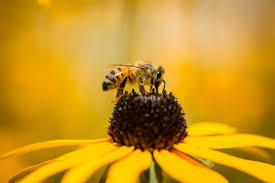The decline of the world’s bee population is sobering, not only as it’s part of an overall decline of pollinating insects, but because it has the potential to affect our food.
Bees are needed to pollinate many edible crops and help produce about a third of our food. They are also needed to pollinate many crops that produce seeds for cultivation.

While the incidence of Colony Collapse Disorder, which wipes out entire hives, has mainly occurred in the United States and Europe, there’s always a chance it could happen in Australia.
There are many reasons for the loss of pollinating insects including; decline of natural habitat, the use of pesticides (insecticides and fungicides), as well as a rise in pests and diseases that attack these insects in their hives, including varroa mite (not yet in Australia).
How You Can Help
The positive news is that every gardener can help bees survive by growing flowering plants and creating a safe, insecticide-free environment. Being bee friendly can be as simple as allowing clover and dandelions to flower in the lawn. The key factors for encouraging bees to your garden are:
– having a wide range of flowering plants
– planting flowers in swathes to make it easier for bees to forage
– having plants in flower throughout the year
– avoiding using chemicals that could harm insects including bees (look for warnings on pesticide containers or ask about organic non harmful products)
– Shallow water sources such as a birdbath filled with small pebbles (so the bees can drink without drowning) can also provide a reason for bees to visit your garden when they’re in search of water as well as flowers.
Even if you don’t have a beehive, there will be bees in your garden. Bees can travel up to five kilometres from their hive to find nectar and pollen, which they carry back. As you look for bees, you’ll also notice other native insects, which may be living in and around your garden.
Bee-Attracting Blooms

Flowers for bees don’t have to be expensive or exotic. Many plants that self-seed produce flowers that attract insects and provide food over a long period of time. Bees are particularly partial to flowers on herbs and vegetables such as coriander, rocket and carrots, but the biggest drawcard is flowering blossom trees including apples, pears and peaches, as well as citrus.
Another winner is borage. This large, hairy herb has brilliant blue flowers that are highly appealing to bees. Borage grows and flowers throughout the year, including in winter, meaning there are always flowers somewhere. I allow it to self-seed along with other year-round flowering plants including calendula, German chamomile, alyssum and nasturtium.
The Delphinium is also another blue flower that is a magnet for bees and happily self-seeds.
However, one of the most spectacular plants to grow for bees is foxglove. If you find a stem in flower, just stand and watch bees crawl into the tubular flower, seeking nectar. Bees regularly visit foxgloves in bloom and as the flowers open gradually up the stem, they provide an ongoing food source through spring and early summer. Buy foxgloves as seed, seedling or flowering plants.
Another plant that’s sure to bring in the bees is salvia. These shrubby perennials are long flowering. Just cut back from time to time to encourage re-blooming. There are many species and varieties that can be mass planted as a feast for bees and other insects and a colourful floral show for us.
Native plants too provide nectar-rich flowers that attract bees as well as native insects and birds. Growing a range of native plants including kangaroo paw, grevillea, hakea, callistemon, tea tree, lilly pilly and banksia ensures flowers throughout the year. Lightly prune after flowering to encourage new growth and another flush of flowers.
And as always if you need inspiration, advice or even just a coffee, buzz on into Wingham Nursery and have a chat to the team.
Caitlin Sawyer
Wingham Nursery
Find us on Facebook
(02) 655 34 570
